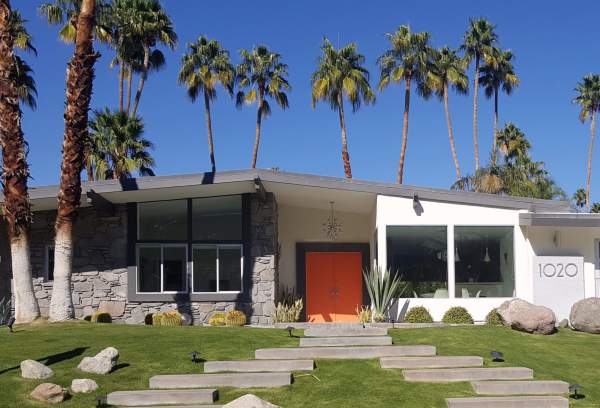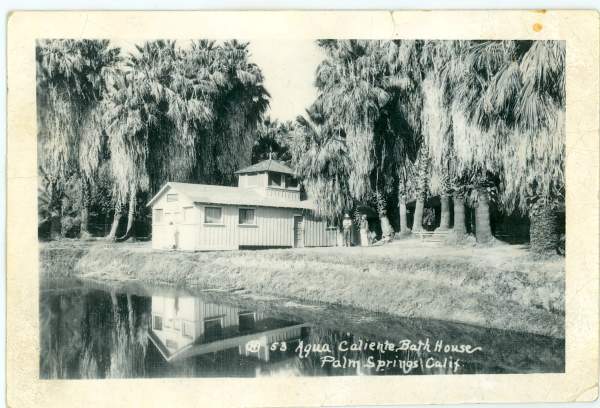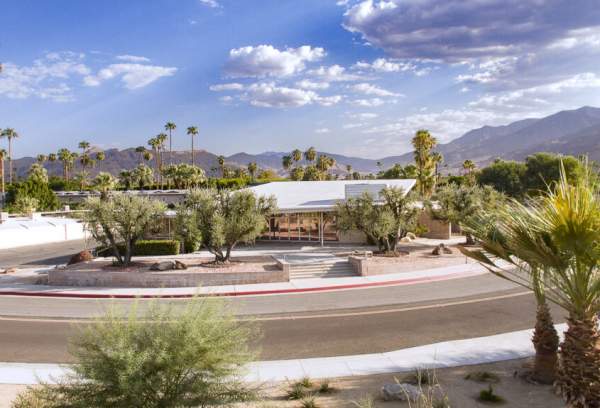Discover the Meaning Behind Palm Springs Street Names
Vista Chino, Farrell Drive, Arenas Road, and Ramon Road—we drive, bike, or stroll down these familiar Palm Springs streets every day. Whether we know them by heart or rely on our navigation apps, these iconic roads form the city's connective tissue.
But have you ever wondered where these Palm Springs street names came from?
Behind the names lie powerful stories that reflect the city’s rich heritage—from groundbreaking legal victories and tribal leadership to Hollywood legends and desert lore. The street signs of Palm Springs are more than just directions—they’re markers of a truly one-of-a-kind history.
🪶 Cahuilla Leaders and Trailblazers: Streets Rooted in Indigenous History
Palm Springs was built on a unique partnership between the Agua Caliente Band of Cahuilla Indians, whose ancestral land includes the famed Agua Caliente hot spring (or Sec-he in the Cahuilla language), and the entrepreneurs and entertainers drawn to the area’s beauty and mystique. Together, they shaped the city into the vibrant, glamorous destination it is today.
Some street names honor influential Cahuilla Elders who fought for land rights and preserved cultural traditions. Others celebrate Old Hollywood royalty and community pioneers who helped put Palm Springs on the global map.

Arenas Road
Named for Lee Arenas (1870-1966), whose lawsuit – Arenas vs. United States – resulted in the epic 1944 U.S. Supreme Court ruling that changed Native American policy – and Palm Springs history – by granting tribal members the right to own (and subsequently sell) individual parcels of Tribal land. This ushered in dramatic city growth and allowed the City of Palm Springs in 1961 to buy the Tribal acreage that houses the Palm Springs International Airport, leading to the airport’s major expansion and landmark Donald Wexler-designed terminal.
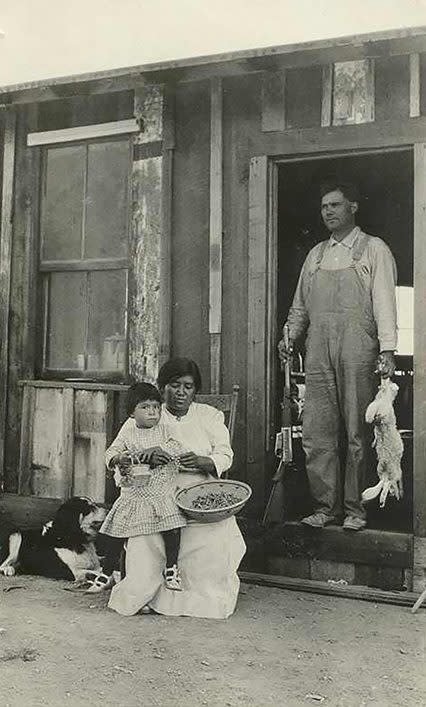
Della Brown, holding Lupe Arenas and Lee Arenas, ca. 1915. Photographer unknown. Courtesy Agua Caliente Cultural Museum Collection.
Calle El Segundo
Honors Clemente Segundo, another legal trailblazer. His 1954 case contributed to the passage of the General Leasing Act of 1955, which permitted long-term leases (up to 99 years) of Tribal lands—a major catalyst for Palm Springs’ mid-century growth.
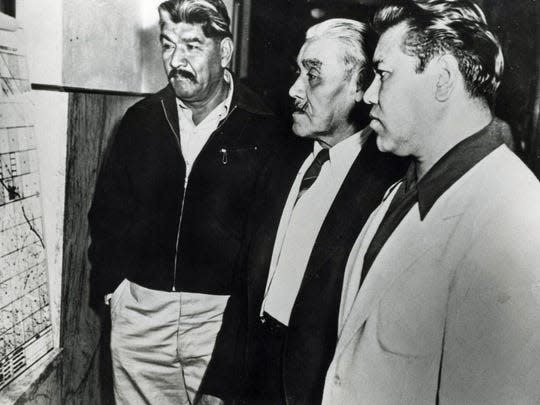
Clemente Segundo, John Joseph Arenas, and Anthony Andreas. 1955. Palm Springs Historical Society.
LaVerne Way
Named after LaVerne Virginia Nelson, an early advocate for Native land allotments. Her efforts supported the push for Tribal sovereignty and economic opportunity.
🔍 Did You Know? Another LaVerne—LaVerne Saubel—made history as part of the first all-women Tribal Council in the U.S. (1954). Along with Eileen Miguel, Elizabeth Pete Monk, Vyola Ortner, and Flora Patencio, Saubel helped bring the Agua Caliente Spa & Hotel to life in 1963, on the sacred hot spring site known as Sec-he.
Largo Circle
Commemorates Manuel Largo (b. 1820), who helped establish over 30 Southern California reservations. A key figure in protecting Indigenous land, Largo was a foundational advocate for tribal sovereignty.
Vista Chino
This street is named for Pedro Chino, the highest-ranking Shaman in the Cahuilla culture. He was a Net (Ceremonial Leader) and a Pavuul (powerful shaman). Chino was also a cowboy who herded cattle in his namesake Chino Canyon. He was said to be 123 years old when he died in 1939.
Pablo Drive
Honors Will Pablo, who, in 1914, collaborated with ethnographers and documented much of what has become the modern understanding of the Cahuilla culture. Pablo also served as the Department of Indian Affairs Prohibition Officer when the Federal government began its crusade against the sale of alcohol on Tribal lands.
Alejo Road
Named for Alejo Patencio (1852-1930), a Net (Ceremonial Leader) and one of the long line of Patencio Tribal activists. He was also an important keeper of the Tribe's oral history.
Belardo Road
This Palm Springs street honors Marcus Belardo and his wife, Rosa. Born in 1860, Marcus was an influential Tribal elder and Alejo Patencio’s Paxaa (assistant with special duties). Belardo’s home (near the Agua Caliente hot spring) was a principal gathering place for tribal families throughout the region.

Marcus and Rosie Belardo with Harry Coffman and Mr. Winter. 1915. Palm Springs Historical Society.
Amado Road
Named for Amado Miguel (1886-1927), a prosperous farmer who teamed up with Marcus Belardo in 1918 and was in charge of growing crops for the U.S. Department of Agriculture.
Andreas Road
Honors John Joseph Andreas (1874-1959), a leading Tribal Elder and gatekeeper at the ancestral Indian Canyons during the 1930s. John Joseph and his son, Anthony Joseph Andreas (1911-1953), also an Elder, were early advocates of maintaining control over Tribal territories.
🏞️ Insider Fact: Andreas Canyon, Andreas Creek Drive, and Andreas Palm Drive are all named in their honor.
Baristo Road
Named for Baristo Sol Santiago (1884-1942), who actively participated in Tribal government and favored traditional communal Tribal lands.
Patencio Road
A tribute to multiple generations of the Patencio family, one of the Tribe’s most influential lineages. Leaders include:
-
Francisco Patencio, who resisted the individual allotment of Tribal land;
-
Albert Patencio, the last ceremonial Net and Bird Singer;
-
Joseph Patrick Patencio, Tribal Chairman during the 1960s.
Insider Fact: Eileen Miguel, president of the nation’s first all-women Tribal Council, was a Patencio -- Joseph Patrick’s sister.
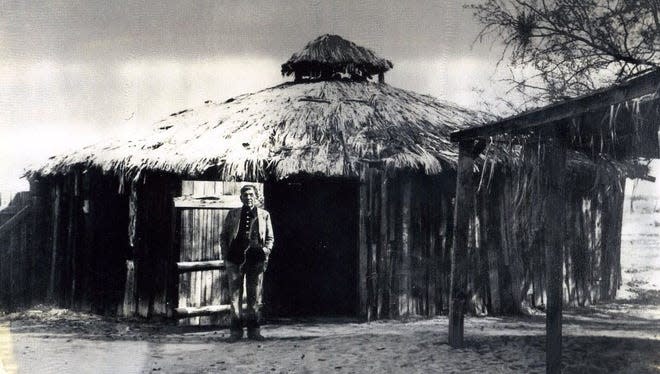
Fransisco Patencio
Ramon Road
Honors Ramon Manuel (1884 - 1942), known for wearing a 10-gallon Stetson cowboy hat, and more importantly, was the powerful Political Chief of the Agua Caliente Band of Cahuilla Indians. He managed the original Tribal bathhouse at the Agua Caliente hot spring and was a staunch Indian rights activist.
Saturnino Road
Named for Miguel Saturnino, a prosperous 19th-century cowboy, rancher, and Tribal leader.
Palm Springs Streets Celebrating Hollywood Legends and Local Icons
The glamor of Old Hollywood is deeply etched into Palm Springs, and several streets honor the celebrities who helped put this desert oasis on the global stage.
Gene Autry Trail
Named for Gene Autry, the “singing cowboy” movie and TV star of the ‘40s and ‘50s, and a Palm Springs entrepreneur. Autry bought his first Palm Springs home in 1940 and a Palm Springs Holiday Inn in 1961, which he turned into the Gene Autry Hotel – now the posh Parker Palm Springs. His mid-century residence on the hotel grounds is an elegant guest suite. Autry also bought a baseball team (the American League Los Angeles Angels) in 1961 and brought it to Palm Springs for spring training through the 1990s.
Insider Fact: While Autry’s namesake is a major thoroughfare, it’s called “Trail” in honor of his cowboy ways.
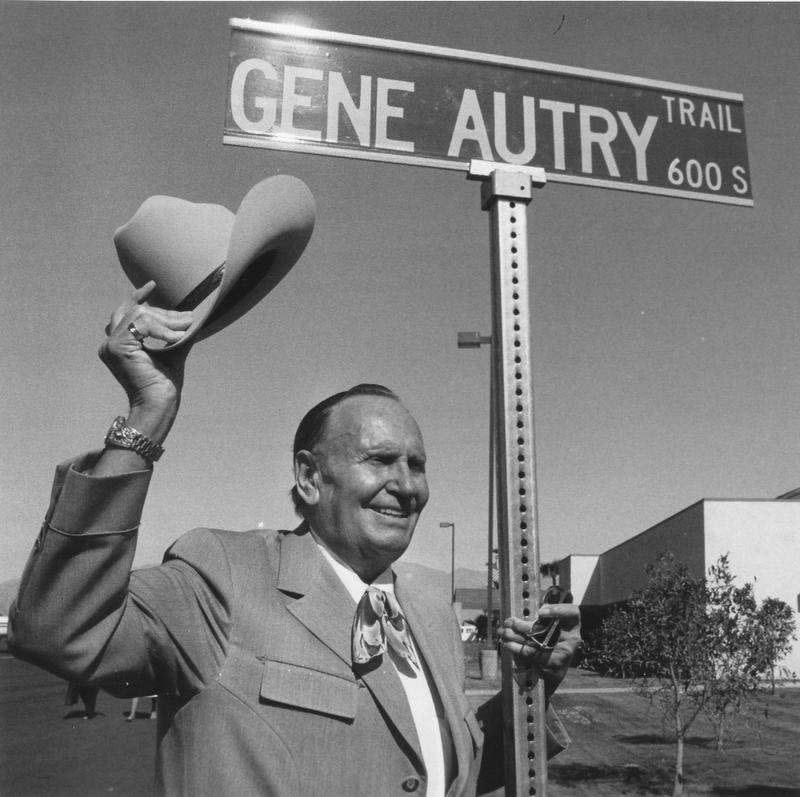
Kirk Douglas Way
Honors movie icon Kirk Douglas (Spartacus! among dozens of others), a Palm Springs booster and resident for more than 40 years (mid-1950s to ‘99). His Donald Wexler-designed home is a Class 1 Historic Site.
Insider Fact: His house backs up to Dinah Shore’s house in the celebrity-packed Las Palmas neighborhood.
Dinah Shore Drive
Dinah Shore Drive is named after Dinah Shore, the vivacious 1940s, ‘50s, and ‘60s singer, TV personality, long-time Palm Springs resident (1952 to '94), and avid golfer. In 1972, she put Palm Springs and the LPGA on the map when she founded the Colgate-Dinah Shore Winner’s Circle golf tournament.
🌟 Celebrity Connection: Her home (now owned by Leonardo DiCaprio) sits back-to-back with Kirk Douglas’s.
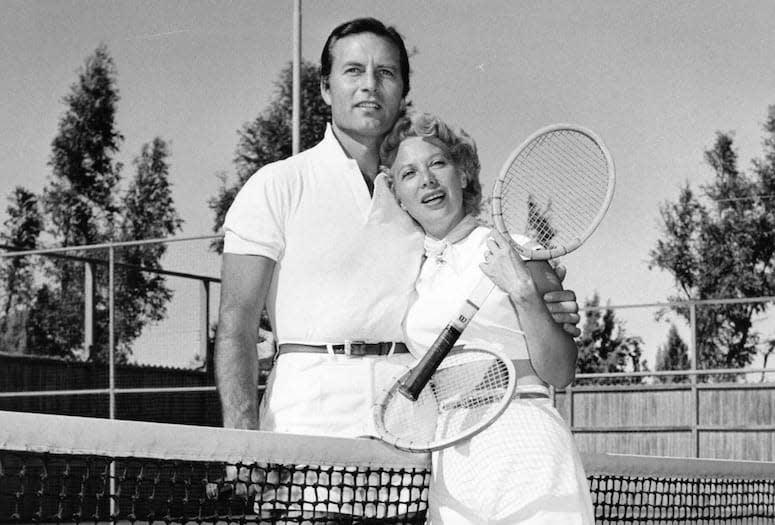
Farrell Drive
Honors Charlie Farrell, a tennis-playing 1920s and ‘30s movie star who founded the glamorous Racquet Club in 1934, a Palm Springs private celebrity hangout for 40 years with fellow actor Ralph Bellamy. He was a dedicated resident and Palm Springs Mayor from 1947 to ’55.
🎬 Behind the Scenes: Farrell is credited with naming streets after celebrities.
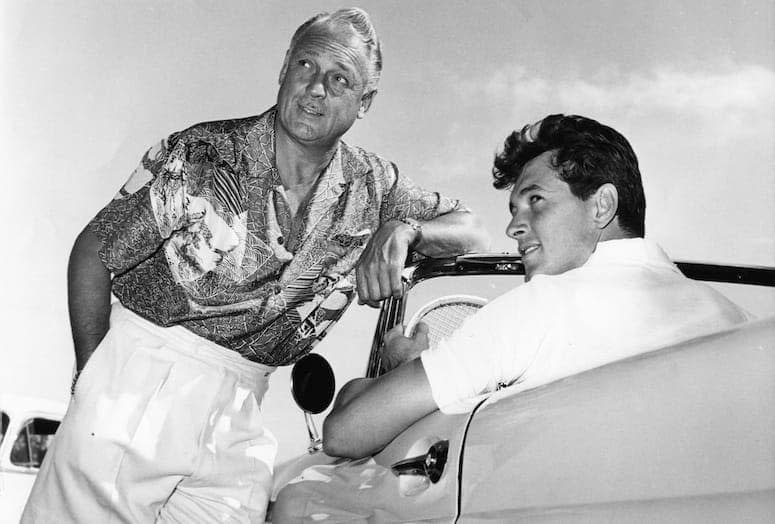
Charlie Farrell and Rock Hudson. Palm Springs Historical Society.
Palm Springs Street Names with Natural and Cultural Roots
Tachevah Road
Named for Tachevah Canyon and Tachevah Creek. This is a bit perplexing since the canyon is scenic, and Tachevah means “plain view” in Cahuilla.
Tahquitz Canyon Way
Celebrates the mystical Tahquitz, a powerful spirit-turned-demon from Cahuilla mythology who is said to dwell in the San Jacinto Mountains.
Chuckwalla Road
Named after the hardy Chuckwalla lizard, a desert native that thrives in the region's heat.
Mesquite Avenue
Refers to the Mesquite tree, an important traditional resource for the Cahuilla people, used for food, tools, and shade.
Cahuilla Road
It is a tribute to the Cahuilla people, whose ancestral territory includes the Coachella Valley, the San Jacinto Mountains, and the Santa Rosa range.
Palm Springs: Where Every Street Has a Story
Whether you're cruising down Farrell Drive or wandering around the Indian Canyons, every corner of Palm Springs whispers stories of resilience, reinvention, and remarkable people. The city’s street names are a living tribute to the Native leaders, visionary pioneers, and star-studded residents who built the oasis we know and love today.
Next time you pass one of these familiar signs, pause and remember: you’re driving through history.
Breaking the Glass Ceiling - Big Time!
Filming locations in Palm Springs
Agua Caliente Tribe: A Brief History
Midcentury Architecture Self-Guided Tour
- 25 min read
Learn more about Palm Springs Architecture on this Self-Guided Tour…
Agua Caliente Hot Mineral Springs: A Sacred Legacy of Healing & Culture
- 4 min read
The History The Agua Caliente Band of Cahuilla Indians has been…
From Sacred Space to Center Stage
- 9 min read
Transforming Frey’s Desert Gem into Dezart Performs Playhouse…
The Plaza Theatre: A Star Returns to the Spotlight
- 12 min read
Built in the striking early Spanish-style architecture, The Plaza…
La Plaza: The Heart of Historic Palm Springs
- 8 min read
The Vision of Julia Carnell Julia Carnell, a philanthropist and…
